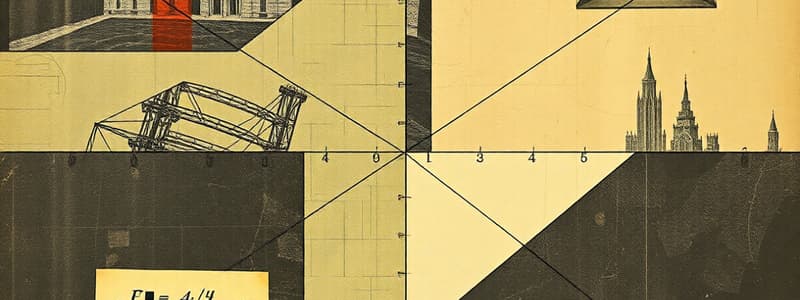Podcast
Questions and Answers
Given points $P(3, 1)$ and $Q(-1, a)$, and that the distance between them is 5 units, find the possible values of $a$.
Given points $P(3, 1)$ and $Q(-1, a)$, and that the distance between them is 5 units, find the possible values of $a$.
$a=4$ or $a=-2$
Two lines have gradients $-\frac{2}{3}$ and $\frac{a}{6}$. If the lines are perpendicular, what is the value of $a$?
Two lines have gradients $-\frac{2}{3}$ and $\frac{a}{6}$. If the lines are perpendicular, what is the value of $a$?
$a = 9$
ABCD is a parallelogram. Given $B(2, 4)$, $C(0, 1)$, and $D(-4, 0)$, find the coordinates of $M$, the point where the diagonals meet.
ABCD is a parallelogram. Given $B(2, 4)$, $C(0, 1)$, and $D(-4, 0)$, find the coordinates of $M$, the point where the diagonals meet.
$M(-2, \frac{1}{2})$
The line through $(2, 1)$ and $(-3, n)$ has a gradient of $-4$. Find the value of $n$.
The line through $(2, 1)$ and $(-3, n)$ has a gradient of $-4$. Find the value of $n$.
Rewrite the equation $4x + 3y = 7$ in the slope-intercept form. Identify the slope and the y-intercept.
Rewrite the equation $4x + 3y = 7$ in the slope-intercept form. Identify the slope and the y-intercept.
Find the equation of the line that passes through the midpoint of the segment connecting the points $(1, 4)$ and $(3, 2)$ and has a gradient of $-2$.
Find the equation of the line that passes through the midpoint of the segment connecting the points $(1, 4)$ and $(3, 2)$ and has a gradient of $-2$.
Determine whether the point $(-2, 5)$ lies on the line defined by the equation $2y + 6x = -2$. Explain your reasoning.
Determine whether the point $(-2, 5)$ lies on the line defined by the equation $2y + 6x = -2$. Explain your reasoning.
Describe the relationship between the equations $y = 2x + 3$ and $2y = 4x + 6$. How would their graphs appear on the coordinate plane?
Describe the relationship between the equations $y = 2x + 3$ and $2y = 4x + 6$. How would their graphs appear on the coordinate plane?
Points A(-1, 4) and B(2, -3) are given. Determine the equation of the line that passes through points A and B.
Points A(-1, 4) and B(2, -3) are given. Determine the equation of the line that passes through points A and B.
Triangle PQR has vertices P(0, 1), Q(-1, -2), and R(3, -3). Classify triangle PQR based on its side lengths. Is it scalene, isosceles, or equilateral?
Triangle PQR has vertices P(0, 1), Q(-1, -2), and R(3, -3). Classify triangle PQR based on its side lengths. Is it scalene, isosceles, or equilateral?
Point A is at (2, 4) and point B is at (k, -1). If the distance between A and B is $\sqrt{29}$ units, find the possible values of k.
Point A is at (2, 4) and point B is at (k, -1). If the distance between A and B is $\sqrt{29}$ units, find the possible values of k.
A quadrilateral OABC has vertices O(0,0), A(5,0), B(8,4), and C(3,4). Given that OABC is a rhombus, demonstrate that the diagonals [OB] and [AC] are perpendicular using gradients.
A quadrilateral OABC has vertices O(0,0), A(5,0), B(8,4), and C(3,4). Given that OABC is a rhombus, demonstrate that the diagonals [OB] and [AC] are perpendicular using gradients.
Two lines have gradients $\frac{4}{-d}$ and $-\frac{d}{4}$. Find the value of $d$ if these lines are perpendicular.
Two lines have gradients $\frac{4}{-d}$ and $-\frac{d}{4}$. Find the value of $d$ if these lines are perpendicular.
The line passing through the points (a, 1) and (2, -1) has a gradient of -2. Calculate the value of a.
The line passing through the points (a, 1) and (2, -1) has a gradient of -2. Calculate the value of a.
Determine the simultaneous solution to the system of equations:
$\begin{cases}
x + 3y = 9 \
2x - y = 4
\end{cases}$
Determine the simultaneous solution to the system of equations:
$\begin{cases} x + 3y = 9 \ 2x - y = 4 \end{cases}$
The graph shows the outflow of water from a tank over time. If the graph is a straight line, what does this indicate about the rate of outflow, and what visual evidence from the graph supports this conclusion?
The graph shows the outflow of water from a tank over time. If the graph is a straight line, what does this indicate about the rate of outflow, and what visual evidence from the graph supports this conclusion?
Flashcards
Point of Intersection
Point of Intersection
A point where two or more lines intersect or cross each other.
Distance Formula
Distance Formula
The distance between two points A(x1, y1) and B(x2, y2) is √((x2 - x1)² + (y2 - y1)²).
Midpoint Formula
Midpoint Formula
The point that divides a line segment into two equal parts. Midpoint M of line segment AB is ((x1+x2)/2, (y1+y2)/2).
Gradient of a Line
Gradient of a Line
Signup and view all the flashcards
Parallel Lines
Parallel Lines
Signup and view all the flashcards
Perpendicular Lines
Perpendicular Lines
Signup and view all the flashcards
Parallelogram
Parallelogram
Signup and view all the flashcards
Y-Intercept
Y-Intercept
Signup and view all the flashcards
What is Gradient?
What is Gradient?
Signup and view all the flashcards
What is a Midpoint?
What is a Midpoint?
Signup and view all the flashcards
Interpreting Gradient
Interpreting Gradient
Signup and view all the flashcards
Scalene Triangle
Scalene Triangle
Signup and view all the flashcards
Rhombus
Rhombus
Signup and view all the flashcards
Study Notes
- Coordinate geometry is covered in Chapter 6
Finding the Intersection of Two Equations
- Equations must be rearranged into the form y = mx + c
- For example, 4x + 3y = 10 becomes y = (-4/3)x + 10/3
- For example, x - 2y = -3 becomes y = x/2 + 3/2
- Enter both functions in the form Y₁ = (-4/3)X + 10/3 and Y₂ = X/2 + 3/2
- Draw the graphs of both functions on the same set of axes and adjust the viewing window if necessary
- Use built-in functions to calculate the point of intersection
- In this case, the point of intersection is (1, 2).
Review Set 6A:
- For points A(3, -2) and B(1, 6):
- The distance from A to B needs to be calculated
- The midpoint of [AB] needs to be calculated
- The gradient of [AB] needs to be determined
- Coordinates of C need to be found if B is the midpoint of [AC]
- Given points P(3, 1) and Q(-1, a) are 5 units apart, the value of a needs to be determined
- Use the distance formula to classify triangle PQR given points P(3, 2), Q(-1, 4), and R(-1, 0)
- Two lines have gradients of -2/3 and a/6; if the lines are parallel or perpendicular, the value of a needs to be determined in each case
- In parallelogram ABCD:
- Coordinates of M, where the diagonals meet, need to be found
- Coordinates of point A need to be found
- The line through (2, 1) and (-3, n) has a gradient of -4; n needs to be determined
- The gradient and y-intercept of the line must be found
- y = 2/5 x + 3
- 2x - 3y = 8
- The equation of the line must be found for:
- Line (1), which is the x-axis
- Line (2)
- Line (3)
- The equation of the line needs to be found, given:
- A gradient of 5 and a y-intercept of -2
- A gradient of 2/3 passing through (3, -1)
- Passing through (4, -3) and (-1, 1)
- The graph of the line with equation x - 2y = 6 must be sketched
- Whether the point (-3, 4) lies on the line with equation 3x - y = 13 needs to be determined
- The point of intersection of 2x + y = 10 and 3x - y = 10, should be found by graphing the two lines on the same set of axes
- Given a graph indicating the number of liters of water which run from a tank over a period of time:
- Gradient of the line needs to be determined
- The meaning of the gradient in the context of water outflow needs to be interpreted
- Whether the rate of outflow of water is constant or variable needs to be determined, with supporting evidence
Review Set 6B:
- For points A(-1, 4) and B(2, -3):
- Needs to be calculated, the distance from B to A
- Needs to be calculated, the midpoint of [AB] -Needs to be found, he gradient of [AB]
- Needs to be found, the equation of the line passing through A and B
- Classify triangle PQR according to its distances, where P(0, 1), Q(-1, -2) and R(3, -3)
- A(2, 4) and B(k, -1) are √29 units apart; determine k
Additional Problems:
- Illustrates the distance traveled for different amounts of fuel at 50 kmh⁻¹ (graph A) and 80 kmh⁻¹ (graph B)
- Determine the gradient of each line
- Determine what these gradients mean
- If fuel costs $1.17 per liter, how much more would it cost to travel 1000 km at 80 kmh⁻¹ compared with 50 kmh⁻¹?
- Prove that OABC is a rhombus
- Showing using gradients, that the diagonals [OB] and [AC] are perpendicular.
- Determine d, given two lines have gradients of -4/d and d/25
- When lines are perpendicular
- When lines are parallel
- Find a, given the line through (a, 1) and (2, -1) has a gradient of -2
- Find the gradient and y-intercept of the lines with the equations:
- y = (x+2)/3
- 3x + 2y = 8
- Finding the equation of the line:
- With a gradient of 5 and a y-intercept of -1
- With x and y-intercepts of 2 and -5, respectively
- Which passes through (-1, 3) and (2, 1)
- Find k, given (2, k) lies on the line with equation 2x + 7y = 41
- Graph the lines x = 2 and 3x + 4y = -12 on the same set of axes
- Graph the equations x + 3y = 9 and 2x - y = 4 on the same set of axes
- Find simultaneous solution of:
- x + 3y = 9
- 2x - y = 4
Studying That Suits You
Use AI to generate personalized quizzes and flashcards to suit your learning preferences.




